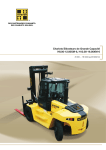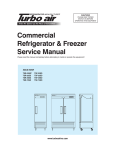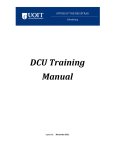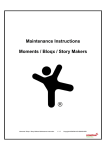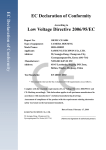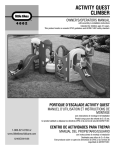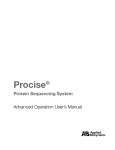Download a set of installation instructions
Transcript
MODEL NO. GS-W1001-1 SINGLE MAST NET CLIMBER INSTALLATION MANUAL Safety Checklist after first assembly ● Test intervals of Safety: 6 months ● Test Component and contents: 1. Removing the reticulated system: - Check of removing condition each rope - Screwing the turn buckle and conversion the turnbuckle in anchors plate(see for this workstep turnbuckle assembly) 2. Abrasion condition of rope: - Checking of all rope surface - Strengthned of rope: Coating on the surface 3. Attachment condition of the anchors plate and turnbuckle 4. Screwing condition of all bolt 5. Galvanizing condition of the steel component: - Protection of steel component from corrosion. ● Measure In case of the appearance the defect detail is repaired usually within 3 days after checking. SHINHEUNG ENG 1046-3, Najeon-ri, Saengnim-myeon, Gimhae-si Gyeongsangnam-do, 621821, Republic Of Korea Tel) +82. 55. 326. 9096~7 Fax) +82. 55. 326. 9022 E-mail) [email protected] Web site) www.gsweb21.com Ver. 070101 1 SINGLE MAST NET CLIMBER INSTALLATION & MAINTENANCE INSTRUCTIONS MODEL NO. GS-W1001-1 Features This series is a pyramid-style climbing structure made of steel-loaded Nylon cables and comes protected against UV. GS Web uses the highest steel content and the strongest connection materials in the industry, including a steel-wire core in our edge ropes and connection points crushed in place with over 75 tons of pressure to ensure long life of the games and maximum safety for the children. GS Web Nets help bring movement, balance, exercise and fun back into the playground. Ages: 3 to 8 years Capacity: 27 children Size: L: 15' 7" / 4.74m W: 15' 7" / 4.74m H: 10' 6" / 3.2m Use zone: L: 25' 5" / 7.74m W: 25' 5" / 7.74m Figure-1: Completed Net 2 MODEL NO. GS-W1001-1 SINGLE MAST NET CLIMBER Safety area and Fall Height zone Safety area The requirements for space and safety clearances are taken from BS-EN 1176-1 / ASTM-F1487 / CSA Z614 The use zone for stationary play equipment shall extend no less than 72 in. (1830mm) from all sides of the play structure. Fall Height : (a) 3' 7" / 1100mm (from surface) The Fall height on the external surface of a pyramid shaped space net is the hightest point attainable within a horizontal distance of (b) 44" / 1100mm from the edge of the structure where a free fall to the protective surface is possible. This distance in based on the centre of gravity height of the maximum (a) user. (b) Imperial/Metric conversion 6' = 1830mm 11' = 3350mm 33' 11" = 10360mm Figure-2: Install and safety area 3 SINGLE MAST NET CLIMBER Foundation Information MODEL NO. GS-W1001-1 Foundation Please refer to GS-W1001-1 drawing for exact installation dimensions Figure-3: Foundation section view Level Line Finished Finished ground Grade surface layer P1 Figure-4 : Excavate enough materials to allow for proper depth of concrete footings P2 Pole Wet concrete Dry concrete (Optional) P1 = Depth below finished Grade (12" / 300mm) P1 = Depth below finished Grade (12" / 300mm) P2 = Depth of concrete footing (27-½" / 700mm) P2 = Depth of concrete footing (27-½" / 700mm) Also ensure that there is enough space to allow the frame to be positioned properly. Anchor wood support frame to ground with pickets to prevent the frame from moving while concrete is poured and sets. 4 MODEL NO. GS-W1001-1 SINGLE MAST NET CLIMBER Foundation Layout Figure-5: Concrete footing and Anchor plate layout Note: Total distance from front of block to front of block is 21' 11" (6700mm) 200 100 100 4" 4" Positioning Anchor plate on footing [CF] 'L" anchor hole Front edge of anchor plate must be installed 4" / 100mm from edge of concrete footing. Imperial/Metric conversion 11' = 3350mm 15' 6" = 4738mm Anchor Plate position 5 MODEL NO. GS-W1001-1 SINGLE MAST NET CLIMBER Concrete Foundation Assemble wooden support frames * 7-⅞" 4 frames (39-½" / 1000mm L x 31-½" / 800mm W x 27-½" / 700mm H) 1 frame (24" / 600mm L x 24" / 600mm W x 27-½" / 700mm H) 7-⅞" 7-⅞" 7-⅞" *Use ½" (min) plywood; not included in package 5-⅞" NOTE: Use anchor plate as guide for exact measurements. (a) (b) (a) wood jig for Anchor plate (b) wood support frame for concrete Figure-6: Wood support frame 6 MODEL NO. GS-W1001-1 SINGLE MAST NET CLIMBER Concrete Footing [Concrete] Pour concrete* into wooden support frame until flush to top edge Allow 3-5 days for concrete to cure before proceeding to next step. [concrete footing work] Pour wet concrete in the wooden support frame *Concrete is to be wet concrete with minimum 25 MPA / 3500PSI. Figure-7: Concrete footing work 7 SINGLE MAST NET CLIMBER Remove Wood Support Frame MODEL NO. GS-W1001-1 Remove wood support frame from dry concrete blocks After concrete has cured enough, remove frame and replace soil in area around footing to subgrade level Figure-8: remove wood support frame 8 MODEL NO. GS-W1001-1 SINGLE MAST NET CLIMBER Anchor Plate Assembly (a) Anchor Plate Figure-9: concreted block clean threads of "L" anchor bolts (b) Post plate (b) Post plate (a) Anchor Plate Figure-10: Attach Anchor plate to footing with flat washer, locking washer and nut. 9 MODEL NO. GS-W1001-1 SINGLE MAST NET CLIMBER Post Assembly Post Assembly Insert Post following nylon string STEP-2 STEP-1 Nylon string Figure-11: Find Nylon String Figure-12: Insert Post following Nylon string NOTE: Remove string prior to placing cap on post. 10 MODEL NO. GS-W1001-1 SINGLE MAST NET CLIMBER Attaching Cap to Post Place Cap on Post Thread the mast through the net’s center (per diagrams below, or following factory-installed guide string). Press the cap (already attached to the top of the net) into the mast’s top end. STEP-3 Figure-14: U-bolt assembly. STEP-4 Figure-13: Insert Post into the Center of Net. Note: Rubber mallet may be required to insert cap into post. Figure-15: Post cap assembly. 11 MODEL NO. GS-W1001-1 SINGLE MAST NET CLIMBER Safety rope Fixing Safety Cable Attaching Attach safety cable to anchor plates (A) (B) (C) as shown in Figure 16. (A) (B) Figure-17: Safety cable Assembly After successfully preparing the net and mast assembly, attach safety cable with M22 X L110 H/T BOLT to Anchor plate as shown below M22 X L110 H/T BOLT (C) (B) (C) (A) Figure-16: Attach cable to (A) (B) (C) 12 MODEL NO. GS-W1001-1 SINGLE MAST NET CLIMBER Placing Post in Position It is strongly recommended that 3-4 workers lift the net into place. [Working Process] (A) (B) (C) (D) (E) (B) (E) (D) (C) Figure-18: Centre Post (A) Figure-19: Safety cables attached 13 MODEL NO. GS-W1001-1 SINGLE MAST NET CLIMBER Stand Net up After standing up the Net, Attach remaining safety rope and Turnbuckles Figure-21: Loosen Turnbuckle: all the way (about 100mm), leaving only 4 or 5 threads attached (F) (B) (E) (D) (C) (A) Figure-20: Stand Net up (A) (B) (C) (D) (E) (F) 14 MODEL NO. GS-W1001-1 SINGLE MAST NET CLIMBER Attaching Turnbuckle to Anchor Plates Anchor plate + Turnbuckle Figure-23: Turnbuckle assembly (b) (a) (a) (b) Figure-22: Tightening Turnbuckles NOTE: Make sure post is level before tightening and remains level during process. (a) + (a) Tighten Rope with Turnbuckles at the Same time (b) + (b) Tighten Rope with Turnbuckles at the Same time 15 SINGLE MAST NET CLIMBER Tensioning & Maintenance information MODEL NO. GS-W1001-1 Maintenance information Please tighten rope with Turnbuckle properly. If you strain the net too much, it may cause damage. It is also recommended that subsequent checks on tension should be carried out at monthly intervals and adjusted as required. This will increase the overall longevity of the product. Checking: 1 month Refer to IPEMA and TUV maintance system. After Net structure tension is completed, the net will stretch slightly over the first four weeks of use. Following this initial period, the net needs to be fully re-tensioned by Turnbuckle after 1 year. Figure-24: completed Net 16 MODEL NO. GS-W1001-1 SINGLE MAST NET CLIMBER Anchor Plate Assembly 8 3 1 1: 2: 3: 4: 5: 6: main post 7: H/T bolt,nut washer 1: main post rope 7: H/T bolt,nut washer multi compound 8: U-bolt,nut,washer multi compound rope 8: U-bolt,nut,washer post2:cap 9: main post plate post cap main post plate turn3:buckle 10: 9: L-anchor bolt,nut,washer 4: turn buckle 10: L-anchor anchor shackle 11: Anchor platebolt,nut,washer 5: anchor 11: Anchor plate shock proof shackle ring 6: shock proof ring 2 5 4 11 7 9 6 10 10 17 SINGLE MAST NET CLIMBER Maintenance MODEL NO. GS-W1001-1 A weekly check of the activity net is recommended to ensure that no acts of vandalism have damaged the rope. Periodic checks on tension will assist in the durability of the product. 18 SINGLE MAST NET CLIMBER Maintenance MODEL NO. GS-W1001-1 A. General safety measures On the playground there should be a sign(pictogram) giving the following information: a) general emergency telephone number; b) telephone number to contact maintenance personnel; c) name of the playground; d) address of playground; and e) other relevant local information, if applicable. The entry, exit and emergency paths to and from a playground, intended for use by the public and emergency services, should be accessible and free of obstacles at all times. NOTE Attention is drawn to local regulations. B. Procedures Defects that occur during operation and which put safety at risk should be corrected without delay. If this is not possible, the equipment should be secured against use e.g. by immobilization or removal. There should be written operational procedures covering the measures to be taken in the event of accidents, fire and the like. Until unsafe equipment is repaired and released for use, access by the public should be prevented. Information about accidents brought to the attention of the manager should be recorded on a form that includes the following details: a) date and tie of accident; b) age and sex of victim and clothing worn, Including footwear; c) equipment involved; d) number of children on site at the time of the accident; e) description of accident; f) injury sustained including part(s) of body affected; g) action taken; h) witness statements; i) any subsequent equipment modification; j) weather conditions; and k) any other relevant information. 19 SINGLE MAST NET CLIMBER Maintenance MODEL NO. GS-W1001-1 C. Routine maintenance To reduce accidents, the owner or operator should ensure that an appropriate routine maintenance schedule is established, implemented and maintained. This should take into account local conditions and the manufacturer's instructions that can affect the necessary inspection frequency. The schedule should list the components to be maintained and should also give procedures for dealing with complaints and breakdowns. The routine maintenance of playground equipment and surfaces should consist of preventative measures to maintain their level of safety, performance and compliance with the relevant part(s) of EN 1176. Such measures should include: a) tightening of fastenings; b) re-painting and re-treatment of surfaces; c) maintenance of any impact attenuating surfaces; d) lubrication of bearings; e) markig of equipment to signify loose fill finished surface level; f) cleaning; g) removal of broken glass and other debris or contaminants; h) restoring loose fills to the correct level; and i)maintenance of free space areas. D. Corrective maintenance Corrective maintenance should include measures to correct defects, or th re-establish the necessary levels of safety of the playground equipment and surfaces. Such measures should include: a) replacement of fastenings; b) welding of welding repairs; c) replacement of worn or defective parts; and d) replacement of defective structural components. E. Personal safety Repairs during operation that could put the safety of maintenance personnel of the public at risk, should be avoided. F. Equipment alterations Alterations to parts of a piece of equipment or structure that could affect the essential safety of the equipment should only be carried out after consultation with the manufacturer or a compete person. 20




















